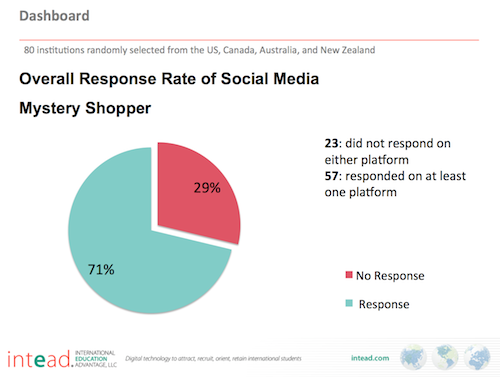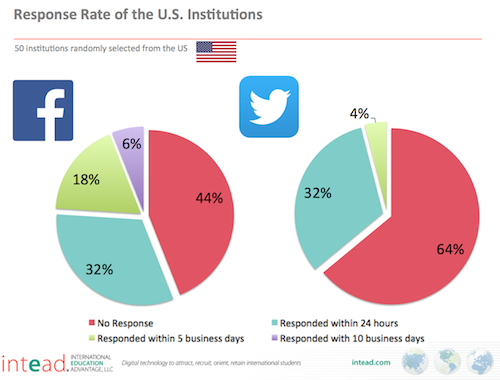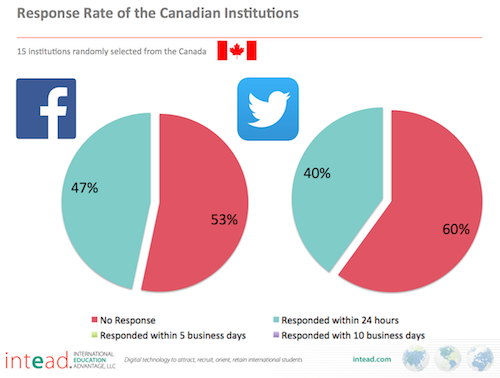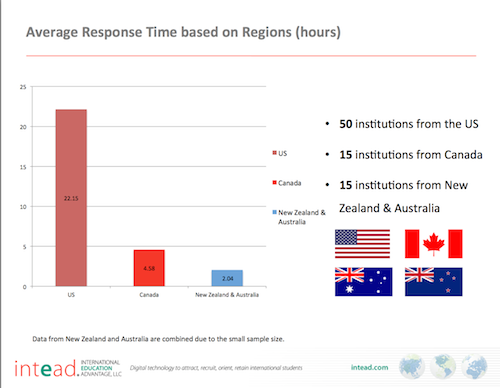What happens when a prospective international student uses Facebook and Twitter to signify her interest in, and hopefully to learn more about, various institutions in the English speaking world? We, at Intead, recently conducted another mystery shopper experiment with institutions in the U.S., Canada, Australia, and New Zealand. As has happened in previous mystery shopper experiments, we were not surprised, yet still disappointed by the dismal rate of response by institutions in these countries. One country proved exceptional in their universities’ ability to respond quickly and effectively. You might be surprised to learn the big winner of this experiment.

In a short span of time it seems as if every institution under the sun has created a Facebook or Twitter account. That, we as marketers know, is a best practice measure. Given the proliferation of social media and the affinity for social media shared by the demographic recruited for higher education, having a vibrant presence on social media is critical. As we have often written and spoken about at conferences just to create a social media account is not enough. In fact, it’s worse to have an unmonitored, ineffective, ignored account than it is to have no account at all. So if it’s a given that institutions should have social media presence, to what extent are institutions taking advantage of that presence? If a student reaches out via social media, is their inquiry replied to quickly and courteously?
This experiment required some creativity on the part of our intern Vanessa Zhu. Vanessa created prospective international student Aahana Bahl, age 22, resident of India. “Ms. Bahl" sent Facebook messages and Tweets from October 24th through November 15th , 2014 to 80 randomly selected institutions— 50 in the US, 15 in Canada, 10 in Australia and 5 in New Zealand— indicating her interest in the institution and the desire to receive more information. The Facebook message and Tweet were simple and straightforward.
Facebook: I'm so excited to study abroad! Please direct me to more information about your international student opportunities.
Twitter: Please tell me more about your international student opportunities. I am eager to learn more! Thanks!
All institutions were sent a Facebook message and a Tweet. The date and time the message was sent was recorded and then the response was closely monitored.
29% of all institutions surveyed did not respond to inquiries placed on either platform. That means 29% of the 80 institutions surveyed— 23 institutions all together— missed an opportunity to engage with an interested prospective student.

Not all countries replied equally. The 29% mentioned above is skewed by the dismal response rate of two countries— the US and Canada. Though we had previously seen Canadian universities have great success in quickly replying to prospective student inquiries (see the first two mystery shopper experiments), this time around Canadian universities were less impressive. Nearly one third of US institutions did not reply to “Ms. Bahl’s” messages posted to Twitter or Facebook. One third of Canadian universities did not reply to “Ms. Bahl’s” messages on either platform.
No response. No opportunity to engage. The funnel is choked off early in the process.


When prospective students research institutions they research multiple institutions, often in multiple countries. “Aahana Bahl” tried to connect with 80 universities as she researched her international study options. As is the case with many international students, she did not limit her research to institutions in the U.S. International students have options throughout the world to spend their time (and money) studying. American institutions need to remember that they are not just competing with each other but with universities in Canada, Australia, New Zealand AND China, Malaysia, etc. When the countries Down Under show that they are more responsive than their North American counterparts, those North American institutions are losing ground.
As has been widely researched and reported, the way that students communicate has changed significantly. This digital native generation uses social media naturally for all kinds of communication. Text messaging, which shows striking similarities to social media messaging in speed and type of response, is the preferred method of communication for this generation. Students do not even want to take the time to read or send emails anymore. This mobile generation wants information in their preferred method on their terms. Higher education marketing has been slow in responding to students’ desires and preferences. For international students, especially, the barrier for communication is lowered significantly with text messaging and social media messaging. In general international students would prefer to read and send messages that are short, sweet, and to the point— exactly the way they communicate with their peers.
What to do?
In our opinion institutions need to respond to this in their marketing efforts. The first step -- creating the social media accounts is just one step forward. Using these accounts to their greatest advantage is the next critical step.
What you need to win the day:
1. A system of creative content generation
2. Consistent monitoring, and
3. Fast replies
This is important, especially since many of your competitors cannot manage this type of marketing program effectively.
Students want to see a quick response to their inquiries. The folks Down Under were the big winners in this category. The average response time for replying to “Ms. Bahl’s” messages on Facebook and Twitter for institutions in Australia and New Zealand was 2.04 hours. For Canadian institutions, 4.58 hours. And for U.S. institutions 22.15 hours. Speed is important, as is the quality of the response.

Interestingly, the response rate on Twitter was, on average, significantly faster than the average response time on Facebook. On Twitter the average was 4.22 hours vs. 11.18 hours on Facebook. Twitter seems to be monitored by institutions more closely than Facebook.
[image]
The kinds of responses “Ms. Bahl” received varied greatly. There were three things we looked for in the response to our social media messages:
1. a timely response
2. making a personal connection
3. providing a relevant link to information requested
Out of courtesy to our colleagues around the world we won’t publicly reveal the list of institutions surveyed in our experiment. However if you’re curious whether you were included, please contact us. We’ll be happy to let you know.
Are you curious about the institutions that were included in the mystery shopper social media experiment? Next week we'll take a look at the winners.

